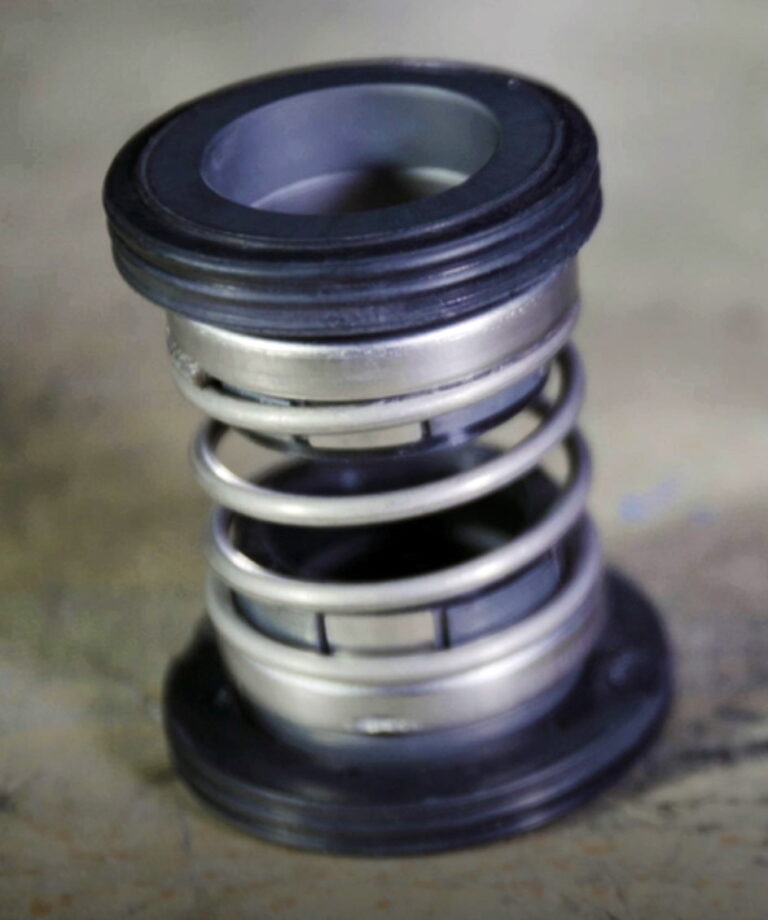
Keeps the pump sealed at the bottom: Mechanical, double internal mechanical seal (Image source: Tsurumi (Europe) GmbH)
It goes without saying that water pumps have to be leak-proof. But the task is technically demanding. “There are two entry points for the water,” explains Stefan Himmelsbach from the construction pump manufacturer Tsurumi in Düsseldorf. “At the top through the cable entry and at the bottom through the shaft seal.” The fatal problem is that the water ingress is not immediately apparent.
The cable option could be largely avoided if the operators treated the pump carefully. This includes, above all, not pulling on the cable, which statistically is a common mistake. Manufacturers install the handle for a reason. Overstretching or friction can create micro-openings through which moisture can penetrate. According to Himmelsbach, Tsurumi pumps are safe in this regard because cable strain relief is present as mechanical protection for the cable inlet. Above all, however, because each conductor is hermetically sealed in synthetic resin – but this is not an absolute guarantee.
Never pull on the cable.
Entry via the seal on the pump opening in the housing base is more delicate. Here, the internal double mechanical seal is considered the gold standard. It works on both sides, with the pressure generated by a strong spiral spring. The lower part is the actual seal (to the outside), the upper part protects the engine compartment.
Tsurumi is the first manufacturer to move this critical component into the oil chamber. There is an oil distributor that lubricates the shaft regardless of its position. As a side effect, it ensures that the frictional heat of the seal in contact with the shaft is dissipated to such an extent that no thermal peaks occur in exposed areas that could lead to material failure. Not all manufacturers do this, especially since the distributor is a Japanese invention. In particular, there are double-acting mechanical seals in which one element is located on the outside and therefore relies on water cooling. The pump then has to pump continuously to be protected – feasible, but with monitoring. The internal oil chamber solution, on the other hand, is safe from dry running.
Visual inspection of the oil
The extremely hard sealing material silicon carbide acts as passive safety: As the second hardest element after diamond, it withstands temperatures of up to 2000 degrees Celsius and thus lasts significantly longer than other seals that manufacturers use, for example made of carbon steel with a thermal upper limit of only 200 degrees.
Nevertheless, even the best seal can fail. It is a multi-stage process, but once the first barrier is overcome, the disaster begins. No manufacturer can guarantee 100% tightness. The reason is the distance between the shaft and the seal, which must always be maintained – otherwise nothing would rotate. The tolerances here are minimal, but sometimes dirt particles penetrate, which have an abrasive effect – and at the end of a cascade of effects destroy the seal. The damage can be caused by the smallest of particles. Even touching the removed seal can be enough. So be careful when carrying out maintenance work!
Be careful when carrying out maintenance
Even a rough fall of the pump onto a hard surface can cause the sealing components, which are only a few millimetres thick, to break. However, the manufacturer Tsurumi has already proven in crash tests that its pumps can withstand an impact on concrete from a height of seven metres.
Himmelsbach advises pump operators to take a simple precautionary measure: check the oil regularly. If it contains water or looks dark and cloudy, the seal is no longer intact. In this case, it must be replaced without touching the sensitive sealing surfaces. It is also helpful to take a look at the shaft protection sleeve or the labyrinth ring in front of the seal – if abrasion is visible here, for example through grinding marks, particles could already have started their disastrous journey into the interior of the pump.